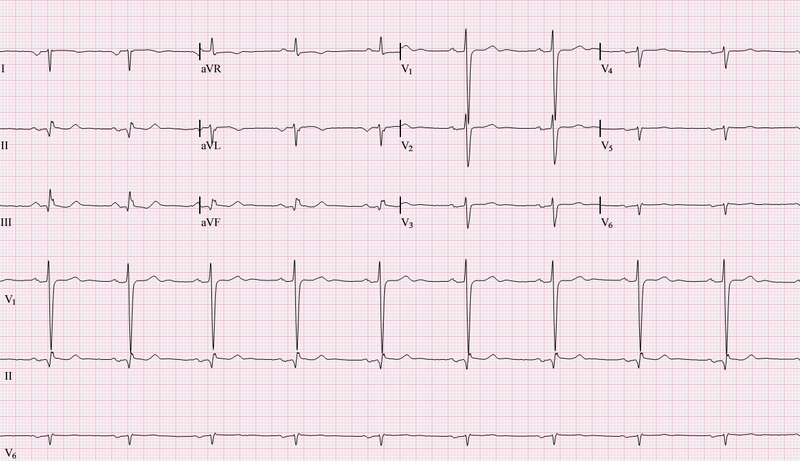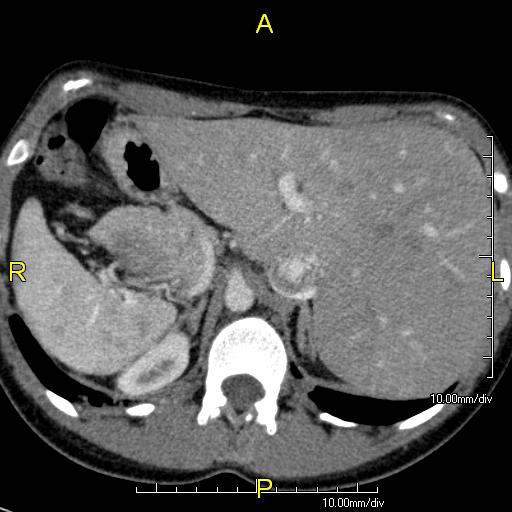WBR0101
| Author | [[PageAuthor::William J Gibson (Reviewed by Yazan Daaboul, M.D. and Rim Halaby, M.D. [1])]] |
|---|---|
| Exam Type | ExamType::USMLE Step 1 |
| Main Category | MainCategory::Genetics |
| Sub Category | SubCategory::Pulmonology |
| Prompt | [[Prompt::A 25-year-old man, with a long history of pulmonary infections, presents to his primary care physician’s office complaining of a persistent cough and expectoration of foul-smelling greenish sputum for the past two months. He explains that he has suffered from recurrent respiratory tract infections since birth. A few months ago, he was prescribed an antibiotic that helped him recover from a similar episode. The patient now seeks a more thorough investigation of his symptoms. On physical examination, pulmonary auscultation reveals diffuse crackles and rhonchi accompanied by a high pitched wheezing during expiration. A recent ECG and abdomninal CT scan of the patient are retrieved from the patient's medical chart and are shown below. Which of the following conditions is this patient most likely to also suffer from? |
| Answer A | AnswerA::Milk allergies and diarrhea |
| Answer A Explanation | [[AnswerAExp::This finding is nonspecific but can be a feature of IgA deficiency, also an immunodeficiency syndrome but not associated with situs inversus.]] |
| Answer B | AnswerB::Ataxia |
| Answer B Explanation | [[AnswerBExp::Ataxia is a feature of ataxia telangiectasia, also an immunodeficiency syndrome but not associated with situs inversus.]] |
| Answer C | AnswerC::Spider angiomas |
| Answer C Explanation | [[AnswerCExp::Spider angiomas are a feature of ataxia telangiectasia, also an immunodeficiency syndrome, but not associated with situs inversus.]] |
| Answer D | AnswerD::Eczema |
| Answer D Explanation | [[AnswerDExp::Eczema is a feature of Wisckott-Aldrich syndrome and IgA deficieny, both of which can cause recurrent pulmonary infections but not associated with situs inversus.]] |
| Answer E | AnswerE::Infertility |
| Answer E Explanation | AnswerEExp::Kartagener syndrome is caused by ciliary dynein arm defects. It is classically described as a triad of situs inversus, bronchiectasis, and chronic sinusitis. It is associated with infertility. |
| Right Answer | RightAnswer::E |
| Explanation | [[Explanation::Kartagener's syndrome (KS), a subtype of primary ciliary dyskinesia (PCD), is an autosomal recessive genetic disorder classically characterized by the triad of situs inversus, bronchiectasis, and chronic sinusitis. However, the clinical features of KS also include rhinitis, chronic otitis, and nasal polyposis. KS is considered a ciliopathy due to missing dynein arms. It results in impaired ciliary movement of the respiratory epithelium, leading to abnormal mucociliary transport and clearance. Similarly, KS is associated with infertility (or hypofertility) due to immobility of sperma flagella, which have core structures similar to those of cilia. Similarly in females, KS leads to hypo/infertility due to abnormal mucociliary transport within the fallopian tubes, increasing the risk of ectopic pregnancy. Finally, KS is also associated with situs inversus, defined as the position of internal organs in the opposite side. Situs inversus may be classified as situs inversus with dextrocardia or levocardia, depending on the position of the cardiac apex. The association between ciliary immobility and situs inversus is thought to be attributed to non-rotational defects of embrionary cell motility of abdominal viscera.
The patient in the vignette presents with recurrent respiratory tract infections with situs inversus with dextrocardia. The ECG of the patient in this vignette shows signs of dextrocardia, such as right axis deviation, tall R waves in lead V1, absent R waves in V6, negative P waves in I and aVL, and positive P waves in III and aVF. His Abdominal CT scan demonstrates situs inversus, showing the liver on the left side and the spleen on the right. Diagnosis of KS is generally made based on clinical features and radiological imaging. However, the ciliary defect among patients with KS may be visually observed using electron microscopy, and use of ciliary beat frequencies can also be helpful in establishing the diagnosis. Management is similar to other cases of bronchiectasis. It is mainly preventative and symptomatic, with goals aimed at providing appropriate prophylactic measures, such as influenza and pneumococcal vaccine, and reducing the disease progression. Rarely do patients require segmental lung resection or lobectomy (eg. to treat recurrent pneumonias or hemoptysis associated with the disease). The prognosis of KS is generally good, with many patients surviving until late adulthood. |
| Approved | Approved::Yes |
| Keyword | WBRKeyword::Genetics, WBRKeyword::Kartagener's, WBRKeyword::Cilia, WBRKeyword::Pulmonary, WBRKeyword::Infection, WBRKeyword::Pulmonary infection, WBRKeyword::Immunodeficiency |
| Linked Question | Linked:: |
| Order in Linked Questions | LinkedOrder:: |

